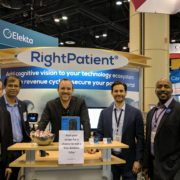Does Renewed Call for National Patient ID Signal…Anything?

Early last week, a group of 25 healthcare organizations representing providers, payers, and health IT companies submitted a letter to members of the House and Senate Committees on Appropriations asking for the removal of a nearly twenty-year-old provision preventing HHS from adopting or implementing a national patient identifier. (source: http://bit.ly/2oQ9PEJ). The goal is to prod Congress to include specific language in the FY18 Labor-HHS spending bill that allows HHS to assist private sector organizations in promoting patient matching initiatives. It’s an unprecedented move to bring yet more attention to the growing and complex problem of accurate patient identification and data matching that continues to plague the healthcare industry from top to bottom, affecting just about every element of care delivery as patients move in and out of the care continuum.

Will the latest letter to Congress asking for the 18 year HHS moratorium on a national patient identifier encourage them to act?
As we have written about before on this blog, we have been saying for years that healthcare simply has to solve the patient ID dilemma and adopt a more holistic approach to patient matching that effectively addresses authentication at the host of new touchpoints borne from the digital health revolution. In fact, hospitals and healthcare systems that invest in patient ID solutions that only cover identification in physical, brick and mortar environments are doing themselves a disservice and severely limiting their ability to ensure patients are kept safe no matter where or in what context they seek care. If any of these institutions plan to participate in local, regional, or national health information exchanges (HIEs) or adopt interoperability standards in the spirit of open and fluid data exchange, they will quickly realize they made the wrong investment choice.
To frame the urgency of the situation, the letter stated:
“According to a recent study of healthcare executives, misidentification costs the average healthcare facility $17.4 million per year in denied claims and potential lost revenue,” the letter stated. “More importantly, there are patient safety implications when data is matched to the wrong patient and when essential data is lacking from a patient’s record due to identity issues.” (Source: http://bit.ly/2oQ9PEJ)
The letter even went on to point out that important initiatives like precision medicine and disease research could continue to suffer and lose significance in the absence of solving the patient ID issue not to underscore the potential negative impact on the aforementioned HIE and interoperability efforts. What’s clear is that millions and millions of research and development capital and manpower has been invested in advancing personalized medicine, data exchange, and interoperability in the absence of solving the problem of inaccurate patient identification and to be honest, we feel that many are starting to get a little nervous.
The question becomes – will this letter actually move the needle and capture the lawmaker’s attention? Considering the new administration’s failed efforts to repeal and replace Obamacare and their healthcare agenda moving forward, our guess is probably not. While we applaud the effort, past attempts to bring this issue to the forefront in the spirit of including language and funding in the HHS appropriations bill that lifts the 18 year moratorium on patient identification have generally stalled. In our opinion, there are too many more high-profile healthcare issues at play that diminish the urgency of solving patient ID in healthcare. Unfortunately, achieving accurate patient ID in healthcare doesn’t carry enough political clout to be considered something worth immediately pursuing and it’s simply not enough of a concern of lawmaker constituents for them to kick up a fuss at the fact that it remains unsolved. At least not yet, anyway.
We wonder….would this group of 25 healthcare organizations be better served to build a larger and more widespread groundswell of support among us, the patients, about achieving accurate patient ID in healthcare instead of going after the big fish (Congress)? Could an argument be made that it’s a more effective strategy to build consensus among patients who, indirectly, can then place pressure on their respective lawmakers to take action? Is it more effective to attack and leverage the power of the voter vs. swaying the whims of Congress? Perhaps, however, it should be noted that grassroots efforts take an enormous amount of time to organize and execute, and the issue of accurate patient ID in healthcare simply can’t afford to wait any longer.
So, we wait. Cautiously optimistic that when framed in the larger context of tangential initiatives failing in the absence of accurate patient ID, 2017 could indeed be the year that Congress takes a step forward in solving the issue. Heaven only knows if they will act, but a step forward is surely more powerful than 18 steps in place.















 Michael Trader is President and Co-Founder of RightPatient®. Michael is responsible for overseeing business development and marketing activities, government outreach, and for providing senior leadership on business and policy issues.
Michael Trader is President and Co-Founder of RightPatient®. Michael is responsible for overseeing business development and marketing activities, government outreach, and for providing senior leadership on business and policy issues.



 Brad Marshall is an Enterprise Development Consultant with RightPatient®. With several years of experience implementing both large and small scale biometric patient identification projects in healthcare, Brad works closely with key hospital executives and front line staff to ensure project success.
Brad Marshall is an Enterprise Development Consultant with RightPatient®. With several years of experience implementing both large and small scale biometric patient identification projects in healthcare, Brad works closely with key hospital executives and front line staff to ensure project success.



 Jeremy has worked in the biometrics industry for nearly a decade and has real world experience with fingerprint, palm vein, finger vein, iris and face recognition technologies. He currently oversees the RightPatient™ Healthcare division of M2SYS Technology, including sales, business development and project management. Before taking over the Healthcare unit, Jeremy spearheaded the growth of the core biometrics division, working closely with Fortune 500 clients like ADP, JP Morgan & BAE Systems to implement biometrics in large identity management projects.
Jeremy has worked in the biometrics industry for nearly a decade and has real world experience with fingerprint, palm vein, finger vein, iris and face recognition technologies. He currently oversees the RightPatient™ Healthcare division of M2SYS Technology, including sales, business development and project management. Before taking over the Healthcare unit, Jeremy spearheaded the growth of the core biometrics division, working closely with Fortune 500 clients like ADP, JP Morgan & BAE Systems to implement biometrics in large identity management projects.